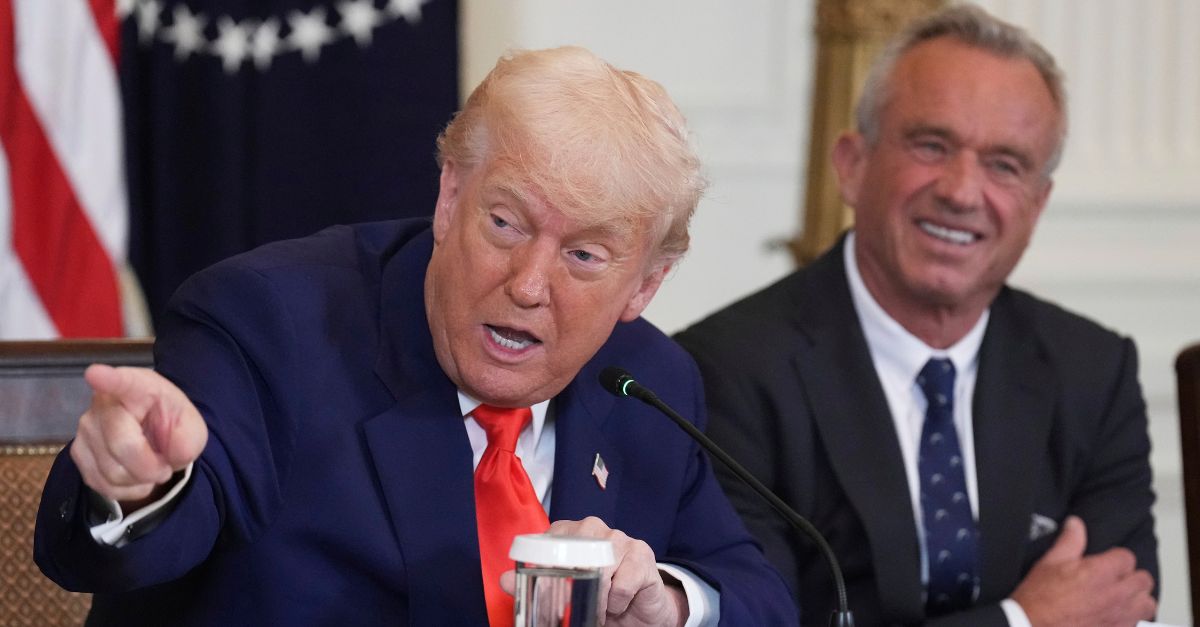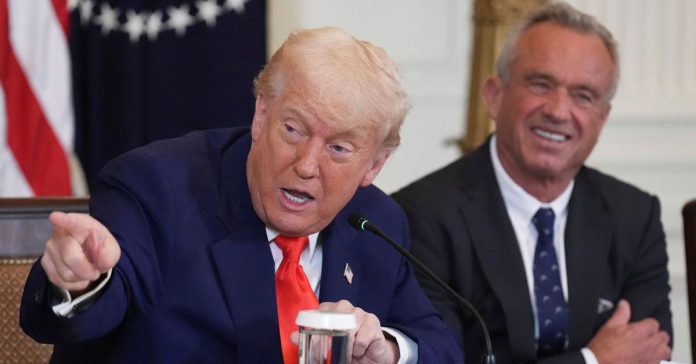
President Donald Trump, left, speaks as Health and Human Services Secretary Robert F. Kennedy Jr. listens during a Make America Healthy Again (MAHA) Commission Event in the East Room of the White House, Thursday, May 22, 2025, in Washington (AP Photo/Jacquelyn Martin).
The Trump administration implored a federal court of appeals to allow significant layoffs at the U.S. Department of Health and Human Services (HHS) to resume as litigation over the authority to conduct such firings continues at the district court level.
On March 27, HHS Secretary Robert F. Kennedy Jr. announced that 10,000 of the agency”s employees would be fired and dozens of sub-agencies would be shuttered in service of the Trump administration’s so-called “Make America Healthy Again” campaign.
On May 5, a coalition of plaintiffs led by New York state filed a 101-page lawsuit alleging the ensuing paralysis at HHS was “the intended result of the March 27 Directive.” On July 1, U.S. District Judge Melissa R. DuBose, a Joe Biden appointee, granted a motion for a preliminary injunction, barring the government from “taking any actions to implement or enforce” any firings or planned restructuring.
Now, the Trump administration is asking the U.S. Court of Appeals for the 1st Circuit to pause the lower court’s order in the name of efficiency, executive management and cost.
Love true crime? Sign up for our newsletter, The Law&Crime Docket, to get the latest real-life crime stories delivered right to your inbox
“The injunction represents a gross incursion on the Executive Branch’s authority to manage its own operations,” the motion reads. “And it requires the government to indefinitely retain and pay employees whose services it no longer requires, even though the government cannot recoup those salaries if it prevails on appeal…To correct those errors and prevent additional harm to the government, this Court should promptly enter a stay pending appeal.”
In its 22-page emergency motion for a stay pending appeal, the U.S. Department of Justice primarily relies on a series of favorable rulings by the U.S. Supreme Court on its so-called “shadow docket.”
In each of three separate, but similar, cited cases, a majority of justices on the nation’s high court stayed district court injunctions barring administrative agencies – like the Department of Education and the Office of Personnel Management – from moving forward with controversial plans to slash federal workforces and end programs.
“Those interim orders ‘squarely control’ here because they necessarily ‘inform how a court should exercise its equitable discretion in like cases,'” the DOJ argues. “The government’s unbroken string of Supreme Court victories on these issues thus confirms that the stay factors are satisfied and the government is entitled to a stay.”
The motion goes on to argue the merits of the case as the Trump administration sees it – by relitigating earlier claims that the district court lacks jurisdiction over the matter. While these claims fell on deaf ears before DuBose, such arguments might convince the appellate panel.
To hear the DOJ tell it, the plaintiff states did not have standing to bring “an amorphous challenge” to the agency’s restructuring efforts “based on speculation” that the remaining employees would be unable to perform statutorily mandated functions assigned to HHS. The motion further argues the lower court “erred” in accepting such arguments.
“Plaintiffs lack standing to bring a broad, prospective challenge based on speculation about the Department’s inability to meet its obligations,” the motion goes on. “Most of the district court’s analysis was premised on the notion that the planned restructuring would harm the states’ citizens, not the states themselves. It is black-letter law, however, that states cannot sue the federal government on behalf of their citizens as parens patriae. A state might respond to a reduction in federal services by providing additional state services, but a desire to ‘supply social services such as healthcare and education,’ is not cognizable.”
The government also insisted the dispute is fundamentally a personnel action and therefore governed by the Civil Service Reform Act (CSRA).
In essence, the DOJ argued that even if the plaintiffs could prove they belong before a court, a district court is the wrong avenue for relief.
“Even if plaintiffs had standing, the district court would still lack jurisdiction to enjoin federal personnel decisions,” the motion goes on. “In the CSRA, Congress ‘established a comprehensive system’ that provides the ‘exclusive means’ for reviewing such matters. And those ‘exclusive means’ are [Merit Systems Protection Board] proceedings brought by affected employees, not lawsuits by third parties in district court.”
In this case, several states are suing – not employees themselves.
The Trump administration argued this state of affairs or more or less proved their point, because “Congress did not create a mechanism for states or other strangers to the employment relationship to challenge the termination of federal employees.”
In short, the DOJ argued the states were intentionally left out of the CSRA – and that federal workers have no other recourse for being fired under the auspices of a reduction in force (RIF), or mass firing.
“Were the law otherwise, gamesmanship would abound,” the motion continues. “Any party believing that a RIF would affect government services could bring a lawsuit until someone found a court willing to enjoin it. This case proves the point: the order in this case requires the government to continue paying employees whose terminations were separately at issue in the [aforementioned Supreme Court shadow docket] litigation.”

